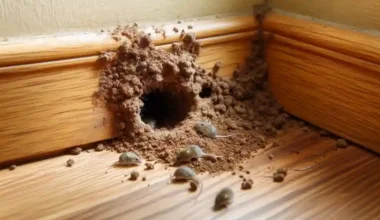With a little effort, you can keep your home safe and mouse-free, which will require you to plug mouse holes with steel wool as one of the steps to eliminate mice and prevent their entry. Usually, you start by inspecting your home for potential entry points, sealing cracks and gaps, removing food sources, and then using appropriate tools and materials to keep mice out. Steel wool is a highly efficient solution for preventing mice, in this guide, we’ll explore how to use this household item to repel mice in simple steps.
How to plug mouse holes with steel wool

Plugging mice entries is easy once you can identify the spots. Below are the steps to follow to plug mouse holes with steel wool:
1. Identify mice and remove them
Consider a safe method that effectively eliminates the mice, usually it has to be a healthy and humane method such as live traps, poisoned baits, and electric traps. Regarding their presence, mouse droppings are a clear sign that you have a mouse problem.
However, if the infestation is severe, DIY methods may not be enough to completely get rid of all the mice. In such cases, seeking the help of a professional pest management company like Integrity Pest Management is recommended.
2. Identify mouse holes
The next step in the process is to stop them from entering your home. Mice can fit into tiny gaps as small as 10mm (the diameter of a pencil), so it helps to identify and seal any gaps or holes in your home. Keep in mind that a mouse can fit through a hole no bigger than a nickel.
Thus, you want to inspect both the interior and exterior of your home to pinpoint potential micr entry points.
Check all potential entry points for mice both inside and outside your home, including kitchen cabinets and appliances, closets, basements and pantries, fireplaces and doors, pipes and plumbing fixtures, floor and dryer vents, attics, garages, and crawl spaces.
Also, to properly plug mouse holes with steel wool, check outside for potential entry points, including the roof, rafters, gables, eaves, windows and doors, the foundation, attic vents, crawl space vents, and holes for electrical, plumbing, cable, and gas lines.
To make sure no potential entry point for mice is overlooked, create a list as you inspect your home, room by room or area by area. This way, you can be sure that every potential entry point is identified and addressed.
3. Gather your plugging materials
You’ll need the following materials to plug mouse holes with steel wool:
- Steel wool (Grade Medium)
- Silicone caulk
Having these supplies on hand will enable you to effectively fill all of the cracks and holes you’ve identified, preventing mice from breaking into your home.
You need silicone caulking because it provides a durable, long-lasting plugging that can withstand moisture and extreme temperatures. It’s an ideal choice for sealing gaps around windows, doors, and in the foundation, as well as for filling holes in the walls. When caulking with silicone, be sure to follow the manufacturer’s instructions for the best results.
4. Plug the mouse holes
It’s time to take action and keep those rodents out of your home. To start, pack the holes you’ve identified tightly with steel wool.
Steel wool material is an effective deterrent for mice and will keep them from entering your home after plugging. After you plug mouse holes with steel wool, use silicone caulk to seal them in place. The caulk will also prevent the mice from ingesting the steel wool.
This two-step process will keep your home mouse-free and prevent any potential health hazards caused by dead rodents in your walls.
5. Discourage mice from lurking around
Store food in a secure location like the pantry or refrigerator, and make sure to keep kitchen counters and floors clean and free of crumbs.
Keep trash in containers with secure lids and dispose of it regularly. When you reduce the food sources available to mice and plug their entry points with steel wool, you effectively eliminate the rodent problem in your home and keep them from coming back.
Make sure to take the necessary steps to make your home less inviting to rodents by eliminating potential food sources and sealing entry points.
6. Inspect your home regularly
Additionally, make it a habit to regularly check for signs of mouse activity, such as droppings or gnaw marks, and take action immediately to prevent a larger infestation. Be proactive to keep mice out of your home and ensure a safe and healthy living environment for you and your household.
With regular inspections, prompt plugging of holes and gaps, and minimizing food sources, you can effectively prevent mice from entering your home. Steel wool is a simple solution that can effectively keep your home rodent-free, so consider implementing this technique in your home maintenance routine.
Can steel wool keep mice out?
Steel wool can keep mice out. To prevent mice from entering your home when you use it to plug all entry points. Conduct a thorough inspection of all areas where food is stored, processed, or used, and look for holes in the walls, doors, gutters, vents, chimneys, electrical and plumbing entrances. Seal any opening larger than a quarter of an inch, and consider sealing smaller holes as well, as mice are known to chew their way through materials.
To effectively block off entry points for mice, use steel wool because they cannot gnaw through it. A mixture of steel wool and the silicone caulking compound is the recommended solution, as it forms a strong and durable barrier. The steel wool provides the necessary stability, while the caulking compound creates a smooth surface that mice cannot penetrate.
Using just steel wool alone is not effective, as mice can pull it out or chew through it.
Copper wool is an alternative to steel wool that may be more effective in deterring rodents. The unique weaving of copper wool makes it difficult for mice to move or chew through, eliminating the need for mixing with caulk before filling holes. Unlike steel wool, copper wool does not rust and won’t cause rust stains on surfaces such as brick, wood siding, or interior walls.






